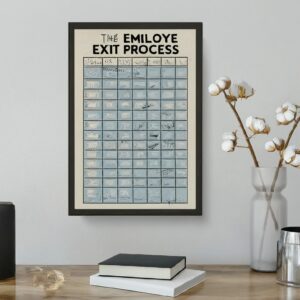Navigating employee exit procedures can be a complex and challenging process for any organization. When not managed effectively, departures can lead to significant risks, including legal complications, security issues, and disruptions in business operations.
However, with well-structured employee exit procedures, these challenges can be transformed into opportunities for improvement and growth. Embracing tools like Seamless HR can significantly enhance these procedures, reducing risks and improving overall outcomes.

The Importance Of Effective Employee Exit Procedures
Risk Mitigation
Effective exit procedures are crucial for mitigating risks associated with employee departures. Poorly managed exits can lead to legal disputes, especially if contractual obligations or company policies are not properly addressed. Additionally, security risks can arise if sensitive information is not handled correctly. Implementing a robust exit procedure helps safeguard against these issues by ensuring that all legal and security requirements are met.
Business Continuity
Ensuring smooth employee exit procedures is vital for maintaining business continuity. Disruptions caused by poorly managed exits can impact productivity and operational efficiency. A structured exit process helps to minimize these disruptions by ensuring that responsibilities are transferred seamlessly and critical knowledge is preserved.
Employee Experience
The way an organization handles employee exit procedures affects not only the departing employee but also the remaining team members. A well-executed exit procedure can leave a positive impression, even on departing employees, and can boost morale among the team. This contributes to a more positive workplace culture and supports overall employee satisfaction.
Key Strategies For Optimizing Employee Exit Procedures
Standardize The Process
Standardizing employee exit procedures across the organization ensures consistency and reduces the risk of errors. Developing a comprehensive checklist and formalizing the steps involved in the exit process can help streamline operations. Seamless HR supports this by automating and standardizing workflows, making it easier to manage exits consistently across various departments and locations.
Conduct Thorough Exit Interviews
Exit interviews are a valuable tool for gathering feedback from departing employees. They provide insights into potential areas for improvement and help identify any underlying issues within the organization.
Best practices for conducting effective exit interviews include asking open-ended questions, documenting responses, and analyzing the data to inform future improvements. Seamless
HR’s tools facilitate the collection and analysis of exit interview feedback, enabling organizations to leverage this information for continuous improvement.
Ensure Compliance And Security
Compliance with legal and security requirements is a critical aspect of the employee exit process. This includes handling sensitive data responsibly, recovering company property, and ensuring adherence to labor laws. Seamless HR’s compliance features and document management capabilities streamline these tasks, helping organizations maintain regulatory compliance and protect sensitive information throughout the exit process.
Transition Knowledge And Responsibilities
Transferring knowledge and responsibilities effectively is essential for maintaining operational efficiency. Developing a clear plan for knowledge transfer, including documentation and training, helps ensure that critical tasks and information are handed over smoothly. Seamless HR’s task management and collaboration features support this process by facilitating the documentation and tracking of responsibilities, making it easier to manage knowledge transfer.
Communicate Effectively
Clear communication is key to a successful exit process. It involves informing the departing employee about the steps involved, as well as keeping the rest of the team updated on the transition. Best practices for communication include setting clear expectations, providing regular updates, and addressing any concerns promptly. Seamless HR’s communication tools help ensure that all stakeholders are informed and engaged throughout the exit process.

Leveraging Seamless HR To Enhance Exit Procedures
Automated Workflows
Seamless HR’s automation features can greatly enhance the efficiency of exit procedures. By automating routine tasks such as document generation and notifications, organizations can reduce manual effort and ensure that processes are executed consistently. This not only speeds up the exit process but also minimizes the risk of errors.
Integrated Document Management
Managing and storing important documents related to employee exits is crucial for compliance and record-keeping. Seamless HR’s integrated document management system provides a centralized location for all exit-related documentation, making it easy to access and manage records. This helps ensure that all necessary paperwork is completed and stored appropriately.
Real-Time Reporting And Analytics
Seamless HR’s reporting tools provide real-time insights into the exit process, allowing organizations to track progress and identify trends. By analyzing this data, businesses can assess the effectiveness of their exit procedures and make data-driven improvements. This capability helps organizations continuously refine their strategies and achieve better outcomes.
Employee Feedback Integration
Integrating feedback from exit interviews into the exit process can lead to significant improvements. Seamless HR’s tools allow for the collection and analysis of feedback, providing valuable insights into the effectiveness of exit procedures and areas for enhancement. This feedback loop ensures that exit procedures are continuously improved based on real-time data.
Implementing Best Practices For Continuous Improvement
Regular Reviews And Updates
Regularly reviewing and updating exit procedures is essential for maintaining effectiveness and relevance. Setting up a schedule for reviewing procedures and incorporating feedback helps organizations stay current with best practices and regulatory changes. Seamless HR’s analytics and reporting features support this process by providing insights into performance and areas for improvement.
Training And Development
Providing training for HR personnel on best practices for managing employee exit procedures is crucial for ensuring a smooth process. Seamless HR can facilitate this by offering training resources and tools that help HR teams stay updated on effective procedures. Investing in training ensures that HR professionals are well-equipped to handle exits efficiently and effectively.
Benchmarking And Learning
Comparing exit procedures with industry standards and learning from best practices can help organizations enhance their own processes. Seamless HR’s data and industry benchmarks provide valuable insights into how other organizations handle exits, offering opportunities for improvement and innovation.
Conclusion
Optimizing employee exit procedures is essential for reducing risks and improving outcomes for organizations. By embracing strategies such as standardization, thorough exit interviews, compliance, knowledge transfer, and effective communication, businesses can ensure a smooth and efficient exit process.
Leveraging tools like Seamless HR further enhances these employee exit procedures by automating tasks, managing documents, providing real-time insights, and integrating feedback.
Ready to optimize your employee exit procedures and improve outcomes? Contact Senrab ConsulTech today to learn how Seamless HR can transform your HR processes and drive success in 2024 and beyond. Don’t miss out on the opportunity to enhance your employee exit procedures and protect your organization’s future!



